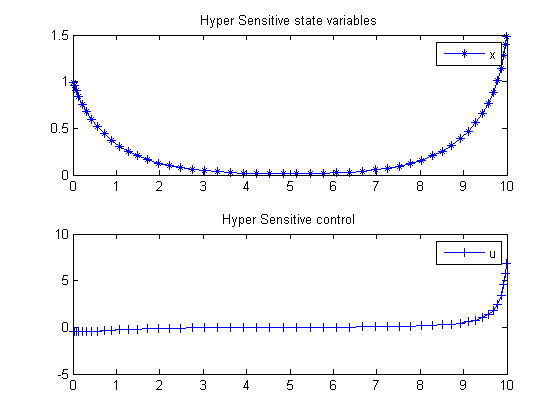Hyper Sensitive Optimal Control
Eigenvector approximate dichotomic basis method for solving hyper-sensitive optimal control problems 2000, Anil V. Rao and Kenneth D. Mease
3.1. Motivating example, a hyper-sensitive HBVP
Contents
Problem Formulation
Find u(t) over t in [0; tf ] to minimize

subject to:




% Copyright (c) 2007-2008 by Tomlab Optimization Inc.
Problem setup
toms t p = tomPhase('p', t, 0, 10, 50); setPhase(p); tomStates x tomControls u % Initial guess x0 = {icollocate(x == 0) collocate(u == 0)}; % bounds and ODEs bceq = {collocate(dot(x) == -x.^3+u) initial(x) == 1; final(x) == 1.5}; % Objective objective = integrate(x.^2+u.^2);
Solve the problem
options = struct;
options.name = 'Hyper Sensitive';
solution = ezsolve(objective, bceq, x0, options);
t = subs(collocate(t),solution);
x = subs(collocate(x),solution);
u = subs(collocate(u),solution);
Problem type appears to be: qpcon
===== * * * =================================================================== * * *
TOMLAB - Tomlab Optimization Inc. Development license 999001. Valid to 2010-02-05
=====================================================================================
Problem: --- 1: Hyper Sensitive f_k 6.723925391388356800
sum(|constr|) 0.000000002440650080
f(x_k) + sum(|constr|) 6.723925393829007100
f(x_0) 0.000000000000000000
Solver: snopt. EXIT=0. INFORM=1.
SNOPT 7.2-5 NLP code
Optimality conditions satisfied
FuncEv 1 ConstrEv 26 ConJacEv 26 Iter 21 MinorIter 70
CPU time: 0.078125 sec. Elapsed time: 0.093000 sec.
Plot result
subplot(2,1,1) plot(t,x,'*-'); legend('x'); title('Hyper Sensitive state variables'); subplot(2,1,2) plot(t,u,'+-'); legend('u'); title('Hyper Sensitive control');
